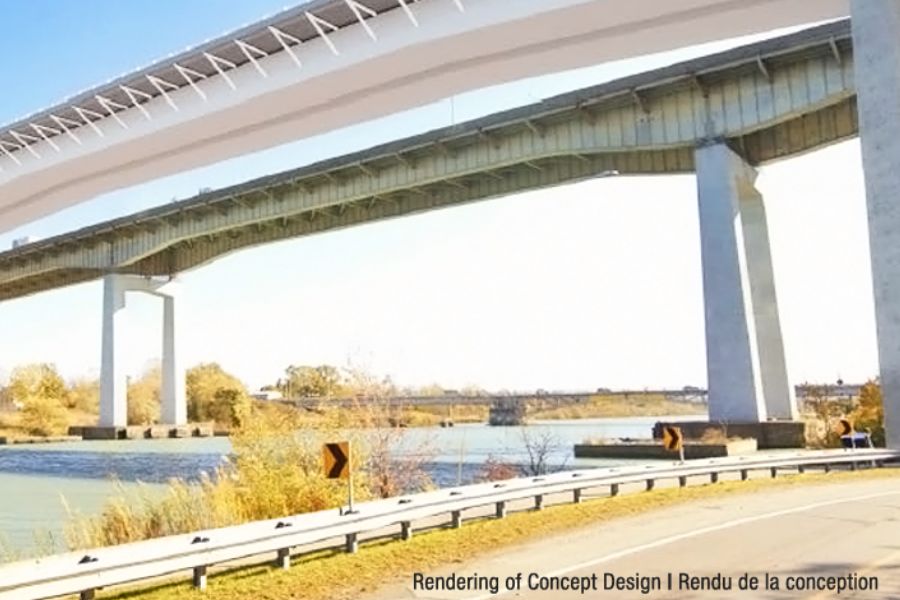Infrastructure Ontario (IO) and the Ministry of Transportation (MTO) have signed a Development Phase Agreement (DPA) with Skyway Bridging Partners (a JV led by FlatironDragados) to advance the QEW Garden City Skyway Bridge Twinning Project. The agreement marks the beginning of detailed design and planning work for a new four-lane bridge across the Welland Canal, positioned adjacent to the existing structure.
Once completed, the new bridge will carry Toronto-bound traffic, allowing the existing bridge to be rehabilitated and used for Niagara-bound travel. The project is being delivered under a Progressive Design-Build model and is intended to improve traffic flow, enhance safety, and futureproof a key transportation link between St. Catharines and Niagara-on-the-Lake.
QEW Garden City Skyway Bridge Twinning - Project Details
The project entails constructing a new 2.2-kilometre, four-lane bridge alongside the existing Garden City Skyway over the Welland Canal. The twinning will separate traffic directions, with the new bridge dedicated to Toronto-bound traffic and the existing bridge rehabilitated for Niagara-bound travel. This approach targets congestion relief and improved traffic flow on a corridor handling over 100,000 vehicles daily.
Additional scope includes widening the QEW approaches, realigning local roads, constructing pier protection systems, retaining walls, stormwater management ponds, and relocating affected utilities. These enhancements are designed to support the region’s growing transportation needs and economic development.

Contract Structure: Progressive Design-Build Model
The project is being delivered under a Progressive Design-Build (PDB) contract model, which is increasingly preferred for complex infrastructure due to its focus on early and ongoing collaboration between the owner and design-builder.
Through the Development Phase Agreement, Infrastructure Ontario (IO) and the Ministry of Transportation (MTO) have engaged Skyway Bridging Partners to jointly advance the project’s design and planning prior to finalizing construction contracts.
Skyway Bridging Partners is a consortium that brings together leading construction and design firms to work closely with IO and MTO throughout both the development and delivery phases.
Lead Applicant: Flatiron-Dragados Canada Inc.
Construction Partners: Construction Demathieu & Bard Inc., Green Infrastructure Partners Inc.
Design Team: Arcadis Professional Services (Canada) Inc., GHD Ltd.
The development phase agreement (DPA) details
The DPA initiates a 19-month development phase where Skyway Bridging Partners will refine design, assess technical and delivery risks, and work closely with IO and MTO to validate scope and budget. Upon successful completion—meeting performance and value-for-money criteria—the parties may execute a final construction agreement.
This phased approach balances cost and delivery certainty for public owners while retaining flexibility to incorporate feedback, reduce lifecycle risks, and optimize design. It reflects a broader industry shift toward integrated, collaborative delivery models, especially for high-value, high-risk infrastructure.

Why use the progressive design-build model?
Aligned with the sector’s move toward collaborative delivery methods—such as Integrated Project Delivery (IPD) method and Alliancing—the PDB model shares key attributes: early contractor involvement, aligned objectives, and shared risk management.
PDB departs from traditional adversarial contracting, favoring transparency, alignment, and performance-based outcomes. For the QEW Skyway project, PDB embraces collaboration principles similar to IPD, particularly in the development phase where joint decision-making balances technical, financial, and operational factors.
Key features include:
Early Contractor Involvement (ECI): The design-builder participates early, contributing constructability insights, phasing strategies, procurement risk mitigation, and scheduling plans well before construction starts. Flatiron-Dragados and partners, including Construction Demathieu & Bard, Green Infrastructure Partners, Arcadis, and GHD, will collaborate with IO and MTO throughout the development phase.
Risk Management & Cost Control: The model supports joint identification and management of risks and costs. As the design progresses, the team works toward a target or fixed construction price, aligning scope, delivery strategy, and funding.
Schedule Optimization: Collaborative planning allows owners to make informed early design and investment decisions, while contractors mitigate risks before breaking ground. This approach helps reduce delays and cost overruns.
Project Strategic Implications: Supporting Regional Growth
The Garden City Skyway twinning is a critical component of Ontario’s transportation strategy, enhancing the movement of goods and people across the Greater Golden Horseshoe. By increasing capacity and infrastructure resilience, the project supports economic growth, reduces congestion, and secures the long-term viability of a vital transportation corridor.
This initiative aligns with the province’s broader infrastructure investment plans, addressing current demands while anticipating future transportation needs.
Related Project and News
- Flatiron and Dragados North America Merge Successfully Complete
- Port of Vancouver Confirms Procurement Process for Roberts Bank Terminal 2 Construction
- DIF-Backed Diverso Energy and Mattamy Homes Announce Strategic Geothermal Partnership
- AECOM Hunt-Turner JV Appointed as Construction Manager for Kay Bailey Hutchison Convention Center Expansion in Dallas










